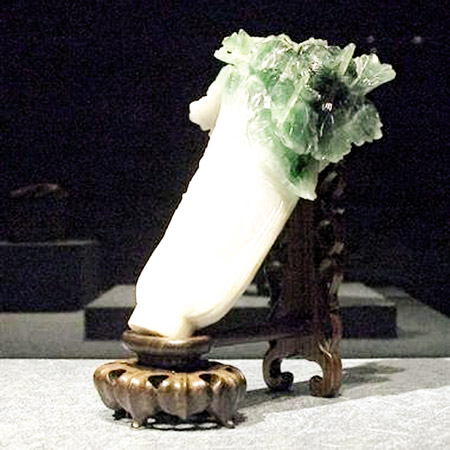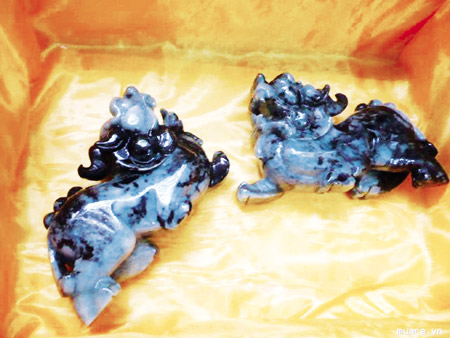Jadeite: The Mystery Behind the Royal Gem
- Lam Lieu
- Mar 15
- 5 min read
Jadeite—known as “ngọc phỉ thúy” in Vietnam—has long been tied to the grandeur of emperors and noble families, often depicted in historical dramas as a rare gem symbolizing power and wealth. With its captivating green hue and mystical allure, jadeite was once the epitome of luxury. Yet today, in Vietnam, this gem floods the market: from delicate bracelets and bead strands to massive statues weighing tens or even hundreds of kilograms, priced from tens of millions to hundreds of millions of VND (roughly $1,000 to $10,000 USD). It begs the question: “Where does all this jadeite come from?” Is this truly the legendary Myanmar jade, or just an overhyped tale?

Jadeite: The Rare Gem from Myanmar’s Depths
To dig deeper, I met Ngô Mạnh Cường, a seasoned jade collector in Hanoi. He explained, “Jadeite is the precious core of a jade block, typically sourced from Myanmar.” This Southeast Asian nation, particularly the Hpakan region, is the only place on Earth where unique geological conditions—volcanic rock in the Earth’s core subjected to millions of years of pressure, heat, and chemical reactions—produce jadeite meeting the highest standards. But this core is minuscule. “Finding jadeite is pure luck,” he said.
Jade enthusiasts often examine the stone’s veins or mossy exterior to guess if jadeite lies within. “Some spend hundreds of thousands of dollars on a block, only to cut it open and find nothing,” Cường recounted with a hint of pity. He noted that jadeite usually appears as small streaks or specks of green within a larger jade mass. In his decades of collecting, he’s only seen tiny jadeite items—beads or ring faces—never large chunks. Showing me a few pieces, he pointed out their deep, translucent green, standing out against the surrounding jade. “Larger items might have a few jadeite specks, but calling them pure jadeite is a stretch,” he insisted.
A spokesperson from Trần Gia Jade Company elaborated: “Jadeite is another name for jadeite jade when it meets strict criteria: an apple-green color (known as ‘xanh lý’ in Vietnamese), translucency, and no impurities. Only Myanmar’s unique geology can craft this rare gem.” Yet not every green jade from Myanmar qualifies as jadeite. “Extracting jadeite is a game of chance,” they said. “The odds are slim, even in Myanmar. Owners rarely sell—it’s often kept as a family heirloom. Buyers are typically tycoons or royalty who have the wealth to chase rarities and no need to part with them.” Indeed, no reports of new jadeite discoveries in Myanmar have surfaced in over a decade.
What makes jadeite so special? “From a distance, it’s unremarkable, but up close, under scrutiny, it’s mesmerizing,” the Trần Gia rep shared. “Its deep green, with misty veins like clouds, sparks curiosity—what else lies hidden? How will it change over time? People can’t stop staring, feeling it’s alive and deeply spiritual.” They concluded: the chance of owning genuine jadeite today is virtually nil.
The products are introduced as Fei cui in the market.
The Jadeite Market in Vietnam: A Mix of Gold and Dross
While jadeite is globally celebrated as a rare gem, in Vietnam, it’s advertised and sold everywhere. Bracelets, necklaces, and display statues weighing tens or hundreds of kilograms—all labeled “jadeite”—carry price tags from tens of millions to hundreds of millions of VND. But Cường shook his head: “These products might contain traces of jadeite, not the whole thing.”
Trần Gia was more blunt: “A lot of the advertising is flat-out wrong. Whether it’s ignorance or intentional deceit, some companies post pictures of opaque white jade, dyed a bright green like young banana leaves, and call it jadeite. Others use grassy green or random artificial shades and claim it’s ‘xanh lý’! It’s either a lack of knowledge or deliberate ambiguity—we can’t say for sure yet. One thing’s certain: I’ve never seen a speck of real jadeite in the products these big Vietnamese companies showcase online.” They acknowledged that sellers might dodge scrutiny by saying, “Our items are similar to jadeite!”
In reality, fake jade and treated jade—bleached with acid, injected with resin, or dyed—are flooding the market, masquerading as authentic Myanmar jade. This muddies the waters, making it nearly impossible for buyers to tell true jadeite from a colorful sham.

Spotting Real Jadeite: Even Experts Struggle
So how do you know if a piece is genuine jadeite? Cường sighed: “Playing with jade is tough. To own the real thing, you need years of study and sometimes costly mistakes to gain hard-earned experience.” On the market, ordinary green jade is often branded “jadeite,” with prices inflated to hundreds of millions of VND. “Only scientific testing can confirm it,” he said, “but Vietnam lacks international gem certification standards.”
I reached out to others in the gem trade for more insight. Most admitted they don’t know much about jadeite because it’s so rare—they barely get hands-on experience with it. Literature on jadeite is scarce, and much of their knowledge comes from word of mouth. Some warned of high-tech fakes: stones irradiated to enhance color, artificially brightened, then hyped with poetic descriptions to jack up prices tenfold, even a hundredfold, beyond their true worth.

Beware of Fake Jade: 4 Expert Tips
Though not specific to jadeite, daquy.org offers valuable advice for gem buyers:
Know Your Gem’s Worth: Understand basic prices. White, rose, smoky quartz, chalcedony, or meteorites are dirt cheap—just a few hundred thousand VND for a few kilograms. But ruby, topaz, sapphire, emerald—and jadeite—are the costly elites. Man-made stones are next to nothing, 20,000-100,000 VND ($1-4 USD) each, with value in craftsmanship, silversmithing, stainless steel settings, and accompanying metal.
Demand Certification: Insist on an appraisal with a unique code. Reputable centers provide details on color, clarity, cut, and testing methods. If all products share one code, it’s a red flag for fakery.
Look Closely: Real gems have veins, fractures, inclusions—however faint—visible under a loupe. Fakes can mimic these now, but careful inspection catches 80%. Don’t trust the old “cool-to-the-touch” trick—fake stones feel cold too!
Vet the Seller: Big stores face sales pressure, sometimes bending the truth to close a deal. Smaller shops or artisans working for gem-processing firms might offer genuine stones at surprising prices.

Jadeite: A Rare Treasure in a Sea of Fakes
Jadeite remains a legend—a rare gem, enchanting and elusive. Yet in Vietnam, the name “jadeite” is tossed around carelessly, often masking a flood of fakes. Without international-standard testing, buyers must rely on knowledge and caution. For now, true jadeite—a gift from Myanmar’s depths—remains a royal treasure, not a common commodity. Want to hunt for authentic jadeite? Arm yourself with skepticism first!
By suckhoedoisong.vn - Lucky Qi edited






